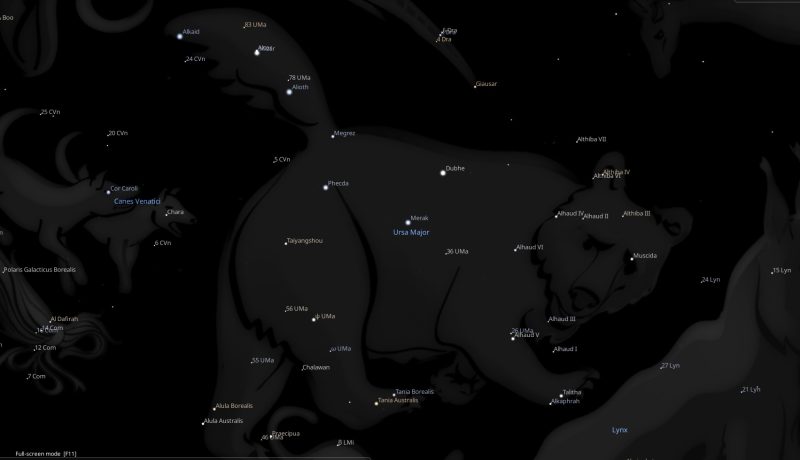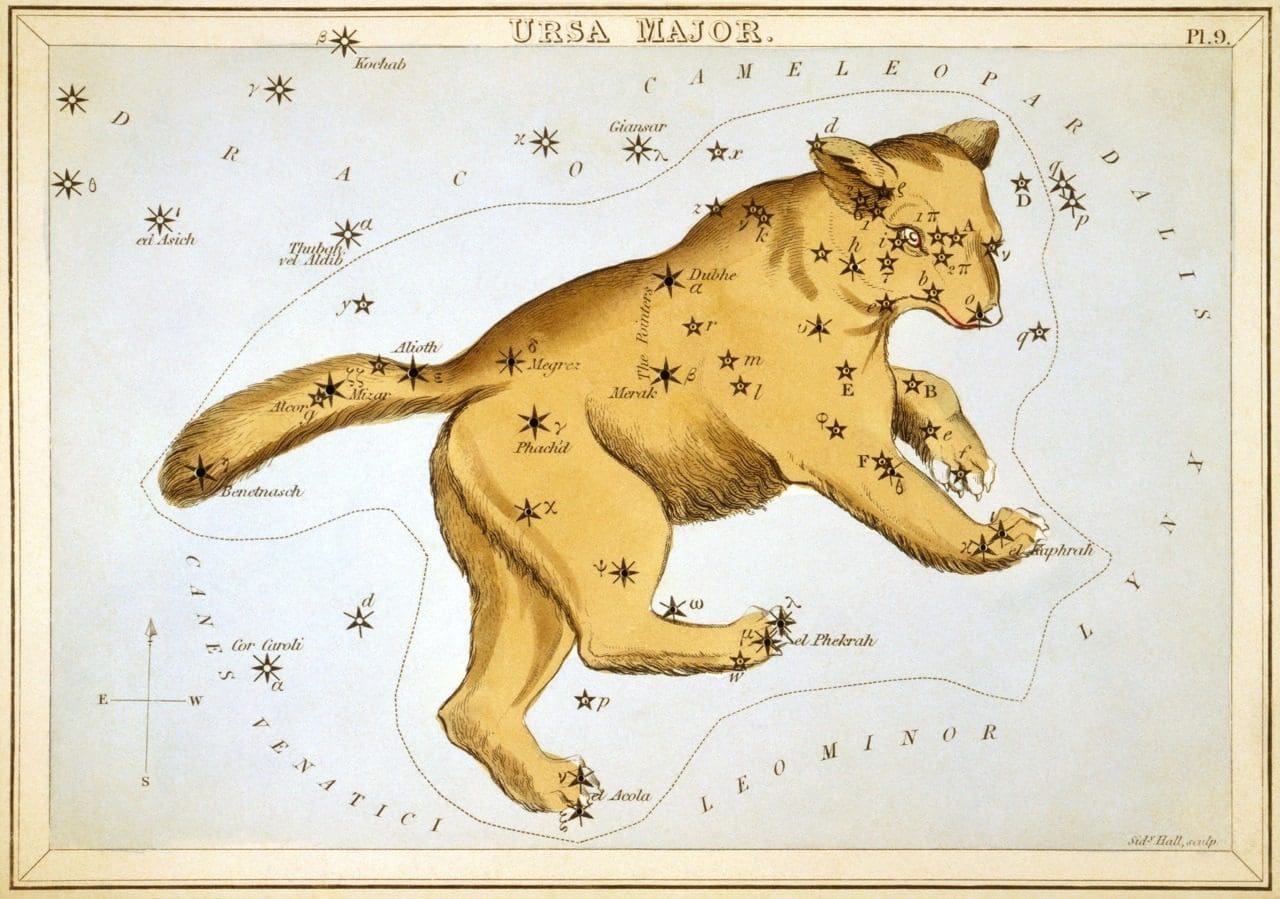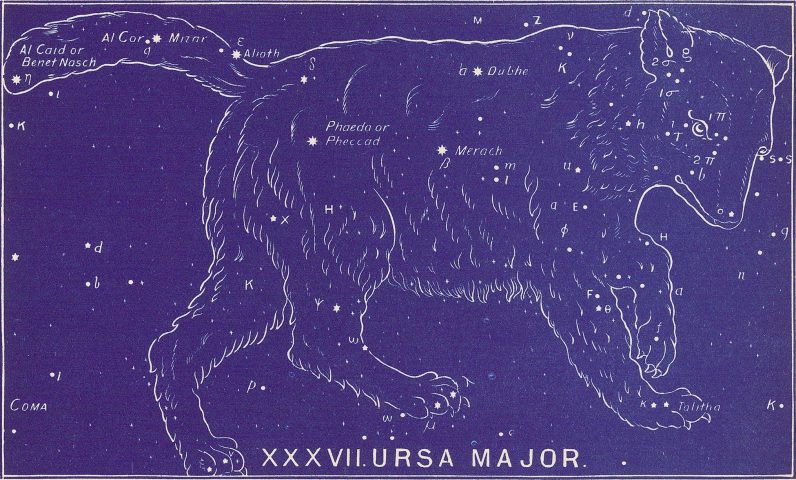FIXED STARS: Major Stars | 1000+ Stars | Constellations | About
Constellation Ursa Major the Great Bear is a northern constellation bordering Boötes, Canes Venatici, Leo Minor, Lynx and Draco. It is one of the 48 constellations listed by Ptolemy in the 2nd century and remains one of the 88 modern constellations. Ursa Major spans over 65 degrees of the zodiac in the Signs of Cancer, Leo and Virgo.Ursa Major Constellation Stars
| 2000 | 2050 | Star | Name | Sp. Class | Mag. | Orb |
|---|---|---|---|---|---|---|
| 21♋38 | 22♋20 | 2 UMa | Althiba I | A2 | 5.47 | 1°00′ |
| 22♋20 | 23♋02 | π1 UMa | Althiba II | G1 | 5.63 | 1°00′ |
| 22♋49 | 23♋32 | π2 UMa | Althiba III | K2 | 4.62 | 1°00′ |
| 23♋00 | 23♋42 | ο UMa | Muscida | G4 | 3.35 | 1°40′ |
| 23♋59 | 24♋41 | ρ UMa | Althiba IV | M3 | 4.74 | 1°00′ |
| 25♋13 | 15♋55 | σ1 UMa | Althiba V | K5 | 5.14 | 1°00′ |
| 25♋19 | 26♋01 | σ2 UMa | Althiba VI | F7 | 4.80 | 1°00′ |
| 26♋20 | 27♋03 | 24 UMa | Althiba VII | G4 | 4.54 | 1°20′ |
| 27♋37 | 28♋19 | τ UMa | Alhaud II | A5 | 4.66 | 1°00′ |
| 00♌50 | 01♌32 | h UMa | Alhaud IV | F0 | 3.65 | 1°40′ |
| 02♌48 | 03♌31 | ι UMa | Talitha | A7 | 3.14 | 1°50′ |
| 03♌07 | 03♌50 | f UMa | Alhaud I | A3 | 4.46 | 1°20′ |
| 03♌20 | 04♌01 | e UMA | Alhaud III | A5 | 4.83 | 1°00′ |
| 03♌57 | 04♌39 | κ UMa | Alkaphrah | A1 | 3.56 | 1°40′ |
| 05♌16 | 05♌59 | 10 UMa | F5 | 3.96 | 1°30′ | |
| 06♌16 | 06♌59 | υ UMa | Alhaud VI | F0 | 3.78 | 1°30′ |
| 07♌16 | 07♌58 | θ UMa | Al Haud V | F6 | 3.12 | 1°50′ |
| 09♌21 | 10♌04 | φ UMa | Alhaud VII | A3 | 4.60 | 1°00′ |
| 15♌12 | 15♌55 | α UMa | Dubhe | K0 | 1.79 | 2°20′ |
| 19♌27 | 20♌04 | β UMa | Merak | A1 | 2.37 | 2°10′ |
| 19♌33 | 20♌16 | λ UMa | Tania Borealis | A2 | 3.45 | 1°40′ |
| 21♌14 | 21♌57 | μ UMa | Tania Australis | M0 | 3.06 | 1°50′ |
| 28♌49 | 29♌31 | ψ UMa | Ta Tsun | K1 | 3.01 | 1°50′ |
| 00♍29 | 01♍12 | γ UMa | Phecda | A0 | 2.44 | 2°10′ |
| 01♍04 | 01♍57 | δ UMa | Megrez | A3 | 3.31 | 1°40′ |
| 03♍40 | 04♍22 | χ UMa | Taiyangshou | K0 | 3.72 | 1°30′ |
| 06♍39 | 07♍22 | ν UMa | Alula Borealis | K3 | 3.49 | 1°40′ |
| 07♍21 | 08♍03 | ξ UMa | Alula Australis | G0 | 4.26 | 1°20′ |
| 08♍56 | 09♍39 | ε UMa | Alioth | A0 | 1.77 | 2°20′ |
| 15♍42 | 16♍25 | ζ UMa | Mizar | A2 | 2.23 | 2°10′ |
| 15♍53 | 16♍36 | g UMa | Alcor | A5 | 3.99 | 1°30′ |
| 26♍56 | 27♍39 | η UMa | Alkaid | B3 | 1.86 | 2°20′ |
Ursa Major Astrology
Robson
URSA MAJOR. The Greater Bear.
Legend. Callisto, daughter of Lycaon, king of Arcadia, of whom Jupiter was enamored, became a follower of Diana on account of her love of hunting. Jupiter sought Callisto by assuming the form of Diana, and Juno who discovered the intrigue turned Callisto into a bear. Angry that the bear was placed in heaven, Juno requested her brother Neptune never to let those stars set within his kingdom, and for this reason they are always above the horizon in Europe. To account for the length of the bear’s tail, it is said that Jupiter, fearing her teeth, lifted her by the tail, which became stretched because of her weight and the distance from earth to heaven.
Influence. According to Ptolemy, Ursa Major is like Mars. It is said to give a quiet, prudent, suspicious, mistrustful, self-controlled, patient nature, but an uneasy spirit and great anger and revengefulness when roused. By the Kabalists it is associated with the Hebrew letter Zain and the 7th Tarot Trump “The Chariot.”
Magical. Gives craft, ingenuity and valor. [1]
Noonan
Astrologically both Bears were said to presage an evil influence. They are particularly injurious as regards to the affairs of nations and kings. [2]
Ursa Major Constellation [Urania’s Mirror]
Allen
Ursa Major, the Greater Bear … always has been the best known of the stellar groups, appearing in every extended reference to the heavens in the legends, parchments, tablets, and stones of remotest times.
It is almost the first object to which the attention of beginners in astronomy is called, — a fact owing partly to its circumpolar position for all points above the 41st parallel rendering it always and entirely visible above that latitude, but very largely to its great extent and to the striking conformation of its prominent stars. It is noticeable, too, that all early catalogues commenced with the two Ursine constellations.
Although the group has many titles and mythical associations, it has almost everywhere been known as a Bear, usually in the feminine, from its legendary origin. All classic writers, from Homer to those in the decline of Roman literature, thus mentioned it, — a universality of consent as to its form which, it has fancifully been said, may have arisen from Aristotle’s idea that its prototype was the only creature that dared invade the frozen North. Yet it is remarkable that the Teutonic nations did not know this stellar group under this shape, although the animal was of course familiar to them and made much of in story and worship. With them these stars were the Wagen, our familiar Wain.
The legend of Kallisto, the beloved of Zeus and mother of Arkas, has nothing to do with the original meaning of the stars. On the contrary, Kallisto was supposed to have been changed into the Arktos or Greater Bear because she was the mother of Arkas, that is to say, of the Arcadian1 or bear race, and her name, or that of her son, reminded the Greeks of their long established name of the northern constellation.
Hewitt says that these seven stars at first were known in India as Seven Bears, although also as Seven Antelopes, and again as Seven Bulls, the latter merged into one, the Great Spotted Bull, as the Seven Bears also p425 were into Ursa Major, with our Arcturus for their keeper; and he gives their individual titles as Kratu for α, Pulaha for β, Pulastya for γ, Atri for δ, Añgiras for ε, and Marīci for η, the six sons of Brahma, who himself was Vashishṭha, the star ζ. The Vishnu-Dharma, however, claimed Atri as their ruler; indeed, there seems to be much variance in Sanskrit works as to the identity of these stars and titles. [3]
Bullinger
It is a large and important constellation, containing 87 stars, of which one is of the 1st magnitude, four of the 2nd, three of the 3rd, ten of the 4th, etc. It always presents a splendid appearance, and is perhaps, therefore, the best known of all the constellations. In the Book of Job (9:9, and 38:31,32) it is mentioned under the name of Ash. “Canst thou guide Ash and her offspring?” which is rendered in the AV, “Arcturus and his sons,” and in the RV, “The Bear with her train” (marg., “sons”). The Arabs still call it Al Naish, or Annaish, the assembled together, as sheep in a fold. The ancient Jewish commentators interpreted Ash as the seven stars of this constellation. They are called by others Septentriones, which thus became the Latin word for North.
The brightest star, α (in the back), is named Dubhe, which, as we have seen, means a herd of animals, or a flock, and gives its name to the whole constellation. The star β (below it) is named Merach (Hebrew), the flock (Arabic, purchased). The star γ (on the left of β) is called Phaeda, or Phacda, meaning visited, guarded, or numbered, as a flock; for His sheep, like the stars, are both numbered and named. (See Psalm 147:4)
The star ε is called Alioth, a name we have had in Auriga, meaning a she goat. The star ζ (in the middle of the tail) is called Mizar, separate or small, and close to it Al Cor, the Lamb. The star η (at the end of the so-called tail) is named Benet Naish (Arabic), the daughters of the assembly. It is also called Al Kaid, the assembled. The star ι (in its right foot) is called Talitha.
The names of other stars all give the same testimony: El Alcola (Arabic), the sheepfold (as in Psa 95:7; and 100:3); Cab’d al Asad, multitude, many assembled; Annaish, the assembled; Megrez, separated, as the flock in the fold; El Kaphrah, protected, covered (Heb. redeemed and ransomed); Dubheh Lachar (Arabic), the latter herd or flock; Helike (so called by HOMER in the Iliad), company of travellers; Amaza (Greek), coming and going; Calisto, the sheepfold set or appointed. [1]
References
- Fixed Stars and Constellations in Astrology, Vivian E. Robson, 1923, p.65, 232.
- Fixed Stars and Judicial Astrology, George Noonan, 1990, p. 7.
- Star Names: Their Lore and Meaning, Richard H. Allen, 1889, p.419-447.
- The Witness of the Stars, E. W. Bullinger, 1893, URA MAJOR (the Great Bear).


